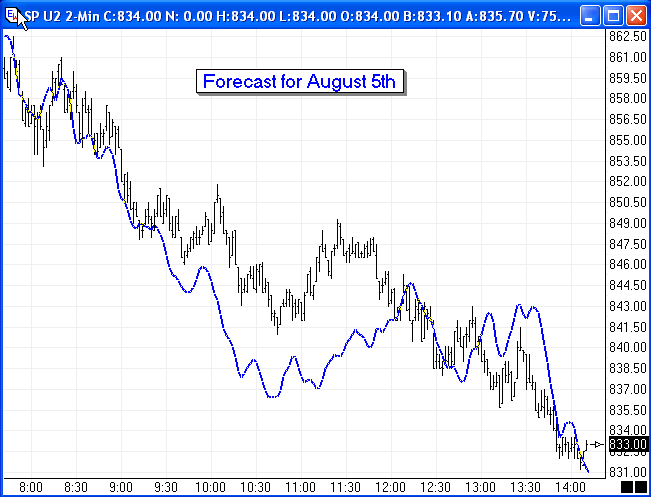by Howard Arrington Neural Networks were discussed in the January 2002 issue of this Trading Tips newsletter. This article is an update on this intriguing subject. In June 2002, Larry Pesavento and Ensign Software signed a cooperation agreement which began the exchange of confidential information about the proprietary neural network used by Larry to give him his timing signals. Larry's method of trading uses one price tool (Fibonacci Levels) and one timing tool (neural net forecast). Larry's trading style was reviewed in the June 2002 issue of this newsletter. A neural network extracts a forecast of tomorrow's price action by examining past data. Sounds a bit mysterious and complex, and indeed it is. We all feel that the market repeats itself, and accordingly use tools like cycles to measure repetitions in time, Fibonacci to measure repetitions in price, and Elliott waves to see repetitions in patterns. A neural network, if designed properly, is allowed to generalize, and through an iterative process discover characteristics in the training data that contribute to a useful prediction. The objective of the Pesavento/Ensign partnership is to design a better neural net. In order to design a better mouse trap, one needs to thoroughly understand the design of an existing mouse trap. Such is the case with the Pesavento neural net. The originator of the Pesavento neural net design back in the early 1990s was Dennis Regan (deceased) . I wish Dennis's thoughts and reasons for why certain things were done had been documented, but alas, such engineering notes apparently do not exist. Therefore, Dr. John Arrington (PhD Stanford) and I have been spent the past couple months reverse engineering the Pesavento neural net, testing and understanding thoroughly every aspect of its unique design. Now I apologize in advance that I cannot divulge all that I have learned. I have signed a non-disclosure agreement with Mr. Pesavento to protect the value of this intellectual property. I will say that I have been totally surprised at the uniqueness of Mr. Regan's design. It is something I would never in a month of Sundays have thought of. In comparison to the neural nets I worked with previously, Mr. Regan's net definitely shows thinking outside of the norm. While I cannot divulge exactly what Mr. Regan's design is, I can tell you what it is NOT. The neural net designs that John and I were pursuing prior to our partnership with Mr. Pesavento, were based on training the neural net with several weeks of past price data and generating tomorrow's forecast using 2-minute bars. We started down that path three years ago because the Pesavento forecasts were overlaid on 2-minute bar charts. Mr. Regan's design is not anything like that, and that initially really surprised both John and I. Initially we wondered if we had the full Regan design because it did not seem like it could possibly work, yet it does. The Arrington model was training with prices on the input nodes of the neural net. The Regan model does no such thing. It does not input prices, and that shocked us. Instead it uses for input what I will describe as a pair of frequencies. The analogy that John and I have used to get a mental handle on what is happening is that of a bat's radar. A bat bounces a frequency off an object, and receives back a three dimensional image on its stereo receivers. The Regan neural net is doing something similar, bouncing frequencies from two different points in time and space and detecting an image. We know that Dennis Regan worked for the U.S. government on the top-secret Tomahawk missile guidance system. Perhaps the design of the Pesavento neural net has its roots in technology Dennis was familiar with. That is just one of our questions that will remain unanswered because Dennis died. Well, we are involved in reverse engineering, researching, thinking, trying variations on the original Regan ideas. Progress seems promising, but all new ideas must weather the test of time. One idea is showing exceptional promise and was used to generate the following forecast for August 5th. The blue line forecast was published in advance on the www.dacharts.com web site on Saturday, August 3rd. I marvel at the correlation of Monday's actual price action. I had a big smile on my face as I watched the day progress and track the forecast. This idea just might be something great.
Not all forecasts are of this quality and usefulness. But when a forecast like the above comes along, it is worth bragging about, particularly since it was published in advance. Let me remind you the key use of the forecast is for TIMING. For example, note the alignment of the top turn at 8:20, the alignment of the bottom turn at 10:42, and the alignment of the top at 13:26. This is exceptional and exactly the trading advantage Mr. Pesavento seeks to have by using neural nets in his trading. (Note: Forecasts may be posted occasionally on the www.dacharts.com web site. I do not know exactly where this project will lead, but offer this as an answer to the frequent inquiry of 'How do I get a hold of these forecasts?'.) |
